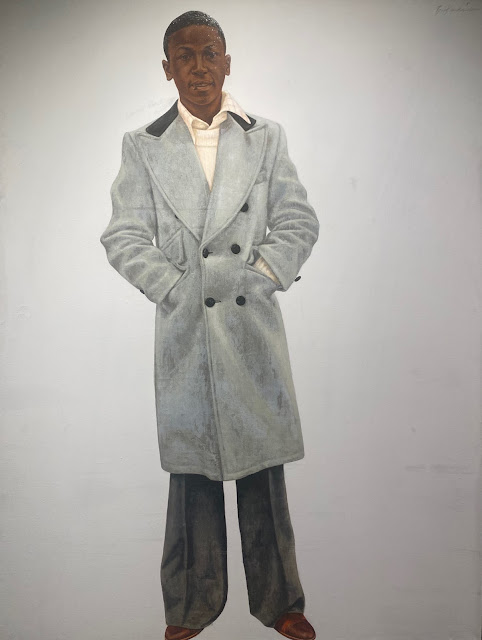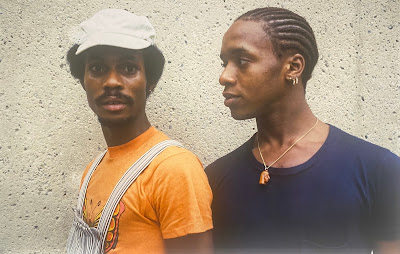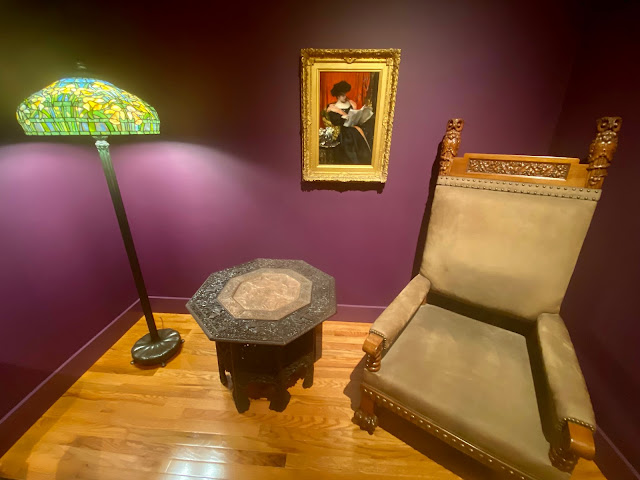I first became aware of Barkley L. Hendricks, seen below, earlier this year for the wrong reasons: why did a gallery show called "Rear View" include his full-frontal nude self portrait?
 |
| Icon for My Man Superman (Superman Never Saved Any Black People - Bobby Seale) (2009) |
Although I still don't know the answer, the artist is a lot more familiar thanks to "Barkley L. Hendricks in New London," a fascinating exhibit at the Lyman Allyn Art Museum curated by Tanya Pohrt. Dr. Pohrt was kind enough to spend some time answering my questions about a superb portraitist who, like Alice Neel, has long been overlooked because both idiosyncratic artists swam against the abstract expressionist tide of the mid-20th century. In fact, Hendricks gave up portraiture for nearly two decades not long after Ronald Reagan's election, a landslide that also made me temporarily flee the country for Australia.
 |
| Dr. Pohrt with "North Philly Niggah (William Corbett) (1975) |
 |
| "Cool Raymond" (1979) |
After giving up portraiture, Barkley turned to landscape painting and photography while teaching art at Connecticut College. Although he insisted his work wasn't political, it's hard not to think of at least some of it that way. African American homosexuality has rarely been as beautifully acknowledged as it is in this photo of two dancers. AIDS eventually snuffed out the life of the man of the right.
 |
| Untitled (1974) |
Barkley lived in New London (where he met his wife, who loaned or donated many of the works on exhibit) from 1972 until his death in 2017. He and a friend, another artist named James "Ari" Montford, attended a Ku Klux Klan meeting just 20 miles north of his home. Here's how the Montford recalled the experience: "They made their pronouncements and then surrounded us and yelled: 'Here! Right here is the problem!' pointing at us and using the N-word. I was stunned and scared." After leaving, Monford added that he and Hendricks "drove to my house and basically sat in my kitchen and said nothing for a very long time. It took a year or two for both of us to process the experience."
 |
| Racesonomic Duncepack Series (1982) |
The exhibit doesn't shy away from the racism Barkley continued to document in Connecticut which passed an act of gradual abolition in 1784. It freed children who were born into slavery at age 25.
 |
| Untitled (1996) |
Call me jaded by my access to world class museums in New York, but IMHO, the Lyman Allyn Art Museum is another of New London's hidden treasures. The collection really is as impressive as the facade which, unfortunately, overlooks the non-stop traffic on I-95.
Speaking of which, the freeway also looms noisily above Old Town Mill, where Randy took us prior to visiting the museum Thursday morning. Built in 1650 by John Winthrop, Jr., the founder of New London and eventual governor of Connecticut, it's now in a kind of no-man's land which sadly discourages tourism. Note to future governors: build highways around cities instead of through them.
Here's Lyman Allyn (1797-1874), the museum's namesake, who parlayed his nautical career into a portfolio of lucrative businesses including banking, insurance and railroad transportation. With a bequest from his youngest daughter, a lifelong resident of New London, the museum was established in 1926 with neither a building nor a collection.
 |
| Portrait of Captain Lyman Allyn by Nahum Ball Onthank (1846) |
By the age of 21, Allyn was the captain of his own whaling boat.
Several enormous oil paintings by Thomas Ferrier Petersen hanging around the staircase emphasize the importance of whaling to the local economy in its early history. They once adorned New London's Mariner's Savings Bank.
We started our tour in the library.
In 1897, Americans could order their firearms from the Sears catalog.
The men's room hasn't changed much since the museum opened in 1932.
A gallery devoted to Louis Comfort Tiffany provided a lot more context for the extensive collection of lamps I recently saw at the New York Historical Society. I hadn't realized his father, Charles Lewis, founded New York City's famous jewelry company on Fifth Avenue.
 |
| Self (?) Portrait of Charles Lewis Tiffany |
 |
| Aesthetic Era Interior (late 19th century) |
 |
| Tiffany Lamps (early 1900s) |
 |
| Tiffany "River of Life" Mausoleum Window (1917) |
 |
| Side Chair by Lambert Hitchcock (19th century) |
 |
| Joined Chest Panel (17th century) |
The museum's small but vibrant collection had more than a few surprises, too. Winslow Homer painted this during a meeting of New York City's Tile Club. Augustus Saint-Gaudens and Stanford White were members, too.
 |
| Shepherdess (1878) |
During a visit to Prague, I was fortunate enough to catch this Czech artist's magnificent Slav Epic which practically requires an airplane hanger to exhibit. With this Art Nouveau gem, he's working on a much smaller scale.
 |
| "Primrose" by Alphonse Maria Mucha (1889) |
Another prolific artist--unknown to me-- cites Caravaggio and Eakins as influences. His work sold steadily probably among buyers who preferred homoeroticism to abstraction. It must have been a very hot night when he painted this scene.
 |
| "Figures by a Fountain" by Walter Stuempfig (ca 1950s) |
I wasn't familiar with Beatrice Cuming either and would not have guessed she painted both these very different works. It appears that New London was a much livelier city before I-95 cut it in half.
 |
| "Saturday Night: New London" (ca 1935) |
 |
| "Chubb" (1944) |
When Randy took us to Waterford Beach upon arrival in New London Wednesday afternoon, we would have a view like this if we had turned away from the sun. You can buy a print on either Amazon or eBay for around $50.
 |
| "New London Light from the North East" by William Gooding (ca 1880-90) |
After the museum, our hostess with the mostest drove us to Stonington for a waterfront lunch at the Dog Watch Cafe. I highly recommend the lobster roll. Good cole slaw, too.
















No comments:
Post a Comment